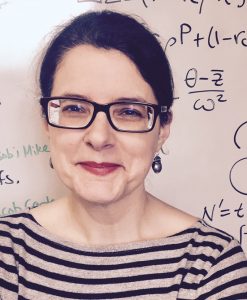
About the author: Dr. Maria E. Orive received her PhD from the University of California, Berkeley, and is currently Professor and Chair of Ecology and Evolutionary Biology at the University of Kansas. While at KU, she spent one year as a fellow at the Radcliffe Institute for Advanced Study at Harvard University. Dr. Orive’s research in theoretical population genetics and evolutionary theory focuses on organisms with complex life histories and studies of population structure, most recently exploring how reproductive mode interacts with spatial processes to affect adaptive evolution.

The President of the AGA is given an incredible gift – the opportunity to choose a topic and invite speakers for a two-day symposium, exploring an aspect of genetics and genomics that helps us understand organismal diversity. For me, it was months of planning and a career’s worth of questions and interactions that laid the foundation.
I could point to the genesis of the symposium as occurring in July of 2018. While at the Society for Molecular Biology and Evolution (SMBE) meetings in Yokohama, Japan, I saw talks by two influential colleagues, Rebecca Fuller and Laura Katz, and spoke to them about my idea for the AGA 2019 President’s Symposium – “sex and asex” and “the genetics of life cycles.” At that meeting, I decided that Sally Otto would be the perfect person to approach to give the Key Lecture, and jotted down notes to invite Katz, Fuller, and another colleague, Curt Lively. But the seeds of “Sex and Asex” were planted long before that.
At the 2017 Evolution meetings in Portland, I went to a talk by Stacy Krueger-Hadfield – I scribbled notes down in the margins of a piece of paper, and underlined “talk to this woman!” twice. Since then, Stacy and I and many others have been involved in several proposals and projects considering the role of partial clonality [life histories including both sexual and asexual (clonal) reproduction] in ecological and evolutionary processes. Early on, Stacy told me of her desire to write a sort of “clonal lexicon” that would bridge the gap between disparate fields. While this introductory paper is not quite what we first envisioned, it is the product of those many discussions.

I had been collecting ideas for this symposium for years, without knowing it. In November of 2016, in a visit to give a talk at Stanford University, I met a graduate student working with Stephen Palumbi named Elora López, whose transcriptomic work in Acroporacorals finally started answering questions I had been thinking about since my own graduate school days. I filed away her name and her work in my memory, knowing I wanted to see more. In 2007-2008, I spent a year at Harvard University, at the Radcliffe Institute as a fellow, and was incredibly lucky to spend a lot of time talking to a smart and creative marine biologist named Randi Rotjan – one of the topics we discussed was the need for scientists working on disparate systems that had important commonalities to come together, such as plant scientists and marine biologists working on clonally spreading invertebrates such as corals – she jokingly said we should call such meetings “Surf and Turf” and lure people in with food. Every time I talked to a scientist who shared my obsession with the push/pull between sexual and asexual reproduction, and clonality, I thought “it would be wonderful to get people together to talk about this.”

So, when did I really start thinking about and planning the 2019 AGA President’s Symposium? We can go back to 1994, when I was writing the introductory chapter for my dissertation. My advisor, Monty Slatkin, told me to take some time to really think about the questions I was asking, and frame my work thoughtfully. I ended up writing about the various forms of clonality, and the many confusing and sometimes contradictory concepts that defined sexual and asexual reproduction. That chapter guided me in setting up this symposium, and our introduction “Sex and Asex: a clonal lexicon.” The symposium ended up being two days of pure scientific fun and the best type of sharing – open and intellectually challenging. And it only took me a quarter of a century to get there.



